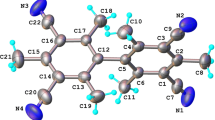Abstract
Multi-tetrazole derivatives with conjugated structures were designed and investigated in this study. Using quantum chemistry methods, the crystal structures, electrostatic potentials (ESPs), multicenter bond orders, HOMO–LUMO energy gaps, and detonation properties of the derivatives were calculated. As expected, these molecules with conjugated structures showed low energies of their crystal structures, molecular layering in their crystals, high average ESPs, high multicenter bond order values, and enhanced detonation properties. The derivative 1,2-di(1H-tetrazol-5-yl)diazene (N2) was predicted to have the best density (1.87 g/cm3), detonation velocity (9006 m/s), and detonation pressure (36.8 GPa) of the designed molecules, while its total crystal energy was low, suggesting that it is relatively stable. Its sensitivity was also low, as the molecular stacking that occurs in its crystal allows external forces to be dissipated into movements of crystal layers. Finally, its multicenter bond order was high, indicating a highly conjugated structure.





Similar content being viewed by others
References
Fischer N, Gao L, Klapötke TM, Stierstorfer J (2013) Energetic salts of 5,5′-bis(tetrazole-2-oxide) in a comparison to 5,5′-bis(tetrazole-1-oxide) derivatives. Polyhedron 51:201–210
Demko ZP, Sharpless KB (2001) Preparation of 5-substituted 1H-tetrazoles from nitriles in water. J Org Chem 66:7945–7950
Zhang J, Mitchell LA, Parrish DA, Shreeve JM (2015) Enforced layer-by-layer stacking of energetic salts towards high-performance insensitive energetic materials. J Am Chem Soc 137:10532–10535
Politzer P, Murray JS (2016) High performance, low sensitivity: conflicting or compatible? Propellants Explos Pyrotech 41:414–425
Ghule VD, Deswal S, Devi A, Kumar TR (2016) Computer-aided design of energetic tris(tetrazolyl)amine derivatives and salts. Ind Eng Chem Res 55:875–881
Wang P-C, Lu M (2011) Regioselectivity nitration of aromatics with N2O5 in PEG-based dicationic ionic liquid. Tetrahedron Lett 52:1452–1455
Wang PC, Zhu J, Liu X et al (2013) Regioselective nitration of aromatics with nanomagnetic solid superacid SO 2−4 /ZrO2-MxOy-Fe3O4 and its theoretical studies. ChemPlusChem 78:310–317
Shen C, Wang P, Lu M (2015) Molecular design and property prediction for a series of novel dicyclic cyclotrimethylene trinitramines (RDX) derivatized as high energy density materials. J Phys Chem A 119:8250–8255
Frisch MJ, Trucks GW, Schlegel HB, et al (2004) Gaussian 03, revision C.02. Gaussian, Inc., Wallingford
Lee C, Yang W, Parr RG (1988) Development of the Colle–Salvetti correlation-energy formula into a functional of the electron density. Phys Rev B 37:785
Lu T, Chen F (2012) Multiwfn: a multifunctional wavefunction analyzer. J Comput Chem 33:580–592
Politzer P, Martinez J, Murray JS et al (2009) An electrostatic interaction correction for improved crystal density prediction. Mol Phys 107:2095–2101
Kamlet MJ, Jacobs SJ (1968) Chemistry of detonations. I. A simple method for calculating detonation properties of C–H–N–O explosives. J Chem Phys 48:23–35
Atkins PW (1982) Physical chemistry, 2nd edn. Oxford University Press, Oxford
Politzer P, Murray JS, Edward Grice M et al (1997) Calculation of heats of sublimation and solid phase heats of formation. Mol Phys 91:923–928
Politzer P, Murray JS (2011) Some perspectives on estimating detonation properties of C, H, N, O compounds. Cent Eur J Energ Mater 8:209–220
Byrd EFC, Rice BM (2006) Improved prediction of heats of formation of energetic materials using quantum mechanical calculations. J Phys Chem A 110:1005–1013
Pospíšil M, Vávra P, Concha MC et al (2010) A possible crystal volume factor in the impact sensitivities of some energetic compounds. J Mol Model 16:895–901
Kosar B, Albayrak C (2011) Spectroscopic investigations and quantum chemical computational study of (E)-4-methoxy-2-[(p-tolylimino) methyl] phenol. Spectrochim Acta A 78:160–167
Scott AP, Radom L (1996) Harmonic vibrational frequencies: an evaluation of Hartree–Fock, Møller–Plesset, quadratic configuration interaction, density functional theory, and semiempirical scale factors. J Phys Chem 100:16502–16513
Acknowledgements
The authors gratefully acknowledge the support provided by the National Natural Science Foundation of China (nos. 51374131 and U1530101).
Author information
Authors and Affiliations
Corresponding author
Electronic supplementary material
ESM 1
(DOCX 193 kb)
Rights and permissions
About this article
Cite this article
Sun, S., Lu, M. Conjugation in multi-tetrazole derivatives: a new design direction for energetic materials. J Mol Model 24, 173 (2018). https://doi.org/10.1007/s00894-018-3710-z
Received:
Accepted:
Published:
DOI: https://doi.org/10.1007/s00894-018-3710-z




